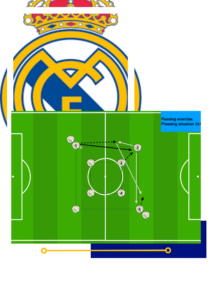Football with Purpose: Training to Play, Not to Repeat
In this section, we will talk about football training drills that I have used with the teams I coached, contextualizing them and analyzing the reasons and objectives behind them.
I hope this does not become a simple copy-and-paste for coaches reading these lines. Instead, I would like this to serve as a reflection, encouraging each coach, within their own team, to conduct a prior analysis of the players and their needs—considering which tool (drill) could help them improve and how it should be executed by both the coach (when designing the training session) and the player.
To begin with, I approach each year as a blank canvas. Every season is unique, and even when I have worked with the same players for years and know them perfectly, I try to start from scratch regarding the ideas of the playing model to be developed and the drills that will be used to achieve it. When I taught courses for coaching licenses at the Real Federación Madrileña de Fútbol (RFMF), I always began my classes with a phrase:
“Every day is different, every week is different, every team is different, and even every year with the same team is different.“
That canvas (whether in PowerPoint or Keynote) starts being developed in the days leading up to the first training sessions, when we analyze the squad and decide, as a coaching staff, the fundamental pillars of the upcoming season. From those initial pages outlining the core principles, it is the players, through training, who show us the “paths” we should follow. During the first few weeks of preseason, as we work on these principles, group behaviors begin to emerge. As coaches, we must be attentive to these behaviors so we can incorporate them into our playing model.
With these behaviors (which will later become principles), new drills will emerge to develop them. This is where the coach plays a key role—offering the group a drill that aligns with the characteristics of the players. This is where a mere copy-and-paste from a book or a video cannot suffice. As coaches, we must have the ability to gather all this information and create a drill that aligns with what we want to achieve and what we need.
As mentioned earlier, the season’s Keynote presentation, initially blank, starts to take shape. And now, I will discuss some of the drills I have introduced at different times with various groups.
Context
It was the 2012/2013 season, and we were coaching Real Madrid’s Alevín B team, alongside my great friend Jose Lara. The group of players we had possessed technical skills above the average for their age. It was the early days of preseason, and the typical warm-up drills we used for that group were not stimulating enough for these young players. So, before one of the sessions, we started working on a new drill that would turn warm-up time into a moment of both training and learning.
To understand my personal context, I view football as a complex sport, where analytical drills with few stimuli are not very useful—especially when the group of players has medium-to-high technical ability. We may use them at some point, but only with secondary objectives.
Based on this premise, the drills we had been using in the first few days involved passing patterns with pre-set instructions (e.g., “play a one-two at this cone,” “position yourself to receive,” “control with the right foot”). However, after some reflection, we came up with the following drill that I am about to share.
Passing Drill with Pressure
This is a square-shaped passing drill that many of us have likely used at some point. The drill starts with a dribble, followed by a pass to the middle, an oriented control… gradually increasing difficulty by adding a one-two at the corners and later involving a third man. If the players are capable, we can even introduce two balls at once.
In our case, we introduced an inner square (which later allowed us to set up a two-square pressing rondo without wasting time rearranging cones, something I will explain another time). We placed four players inside this square. When the teammate in front of them was about to receive a pass, they had to apply pressure—starting in a semi-passive manner at the beginning and then progressing to an active approach in later stages.
Depending on how this player approached to defend, the receiving player and the passer had to adjust their movements and technical actions to solve the situation: using an oriented control and shielding the ball with their body, executing a one-two with the passer (who had to provide a passing option), or even involving a third man (who had to be active to offer another passing option).
With this drill, we made warm-up time more effective and engaging by integrating meaningful game situations.

Key Considerations
- The dimensions should be adjusted according to the players’ conditions.
- Rotation is inside-out, always after resolving the game situation.
- To facilitate the drill’s progression, it can begin without pressure, with players starting from inside the square (as shown in the video).
Want more insights on football training and tactics? ⚽🔥
📲 Follow us on Instagram for exclusive content, practical tips, and in-depth discussions: @alexdorateam
🔗 Read more articles here! 🚀

